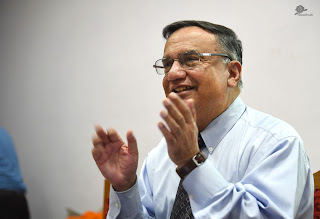Applications of Adaptive Optics | A lecture by Prof. Brij N. Agrawal | IIT BHU | English
Institute Lecture Series Indian Institute of Technology (Banaras Hindu University), Varanasi
& Technex-17 brings you the 26th Institute Lecture & the Fifth Pre-fest Think Talk of Technex ’17
Professor Brij N. Agrawal
Distinguished Professor in the Department of Mechanical and Aerospace Engineering, Director of the Spacecraft Research and Design Center, and Director of the Adaptive Optics Center of Excellence at the Naval Postgraduate School (NPS), USA
Has delivered on
Lecture Title: Applications of Adaptive Optics in Imaging Satellites, Ground Telescopes, and Lasers
Day & Date: Wednesday, the 16th November, 2016
Time : 05 .00 p. m.
Venue : Professor Gopal Tripathi Auditorium, Department of
Chemical Engg & Technology, IIT(BHU), Varanasi
Professor G. V. S. Sastry, Actg. Director, shall preside.
About Dr. Brij Agrawal
Dr. Brij N. Agrawal is currently a Distinguished Professor in the Department of Mechanical and Aerospace Engineering, Director of the Spacecraft Research and Design Center, and Director of the Adaptive Optics Center of Excellence at the Naval Postgraduate School (NPS), USA. He has developed teaching and research programs in spacecraft design, acquisition, tracking and pointing, jitter control, and adaptive optics control for imaging spacecraft, laser communications, and high energy laser beam control. Prior to Joining NPS in 1989, Prof. Agrawal worked for twenty years in R&D and development of several communications satellites for Communications Satellite Corporation (COMSAT) and International Telecommunications Satellite Organization (INTELSAT).  Professor Agrawal wrote the first textbook on spacecraft design: “Design of Geosynchronous Spacecraft.” He has been thesis advisor for 10 Ph.D. and 45 MS students. He has two patents, one on attitude control and the other on jitter control. Prof. Agrawal has published over 150 papers in journals and conference proceedings. He has received several awards. He received B.Sc. (Hons) in Mechanical Engineering in 1964, ME (Hons) Mechanical Engineering in 1966, IIT Roorkee, MS Mechanical Engineering, 1968, Mc Master University, Canada, Ph.D. Mechanical Engineering, 1970, Syracuse University, USA. He is a Fellow of the American Institute of Aeronautics and Astronautics (AIAA) and Academician, International Academy of Astronautics.
Professor Agrawal wrote the first textbook on spacecraft design: “Design of Geosynchronous Spacecraft.” He has been thesis advisor for 10 Ph.D. and 45 MS students. He has two patents, one on attitude control and the other on jitter control. Prof. Agrawal has published over 150 papers in journals and conference proceedings. He has received several awards. He received B.Sc. (Hons) in Mechanical Engineering in 1964, ME (Hons) Mechanical Engineering in 1966, IIT Roorkee, MS Mechanical Engineering, 1968, Mc Master University, Canada, Ph.D. Mechanical Engineering, 1970, Syracuse University, USA. He is a Fellow of the American Institute of Aeronautics and Astronautics (AIAA) and Academician, International Academy of Astronautics.
He has collaborated in India at ISRO and DRDO. At ISRO, he participated in the early phase development of INSAT 1, first Indian communications satellite, 1977-78. At DRDO, he has given short courses in space systems and adaptive optics for high energy lasers. For recently approved multiyear joint project between DRDO, India and Department of Defense, USA, he is the principal investigator on the application of adaptive optics to correct the high energy laser beam aberration due to air turbulence.
Additional links:
*NPS Vita for Brij Agrawal
http://faculty.nps.edu/vitae/cgi-bin/vita.cgi?p=display_vita&id=1023567618
*Dr. Brij N. Agrawal, Ph.D, Distinguished Professor
Director, Spacecraft Research and Design Center
http://www.nps.edu/academics/centers/srdc/People/Director.html
 |
| Prof. Brij N Agrwal receiving distinguish alumnus award at IIT(BHU) |
Abstract the Lecture
This Lecture will provide an overview of adaptive optics and its applications to imaging satellites, ground telescopes and laser systems. It will also provide an overview of research performed at NPS in Adaptive Optics Center of Excellence in these areas. NPS has Segmented Mirror Telescope (SMT) testbed. SMT consists of 3 meter diameter space telescope with 6 segments. Each segment has 156 actuators for surface control and three fine and 6 coarse actua
 |
| Prof. Brij N Agrwal with Prof. SK Sharma (Head Dept. of Mining Engineering IIT-BHU) |
tors for segment phasing. It has Shack-Hartmann wave front sensor for surface control and phase diversity sensor for segment phasing. It also has Fast Steering Mirror for jitter control. These mirrors need to have very fine surface accuracy in the range of 30 nm RMS. Research is also performed on reducing primary mirror surface performance requirements by adding a deformable mirror in the optical path. Another area of research is correcting laser beam aberration due to atmosphere turbulence by using adaptive optics. Applications are laser communications and high energy lasers.
————————————————————
like us- http://facebook.com/rosehubIndia
visit us- http://rosehub.in
Subscribe- http://goo.gl/l9JOrx

